Abstract
OBJECTIVE: The authors determined the prevalence of foreign body granulomas in intra-abdominal adhesions in patients with a history of abdominal surgery. PATIENTS AND METHODS: In a cross-sectional, multicenter, multinational study, adult patients with a history of one or more previous abdominal operations and scheduled for laparotomy between 1991 and 1993 were examined during surgery. Patients in whom adhesions were present were selected for study. Quantity, distribution, and quality of adhesions were scored, and adhesion samples were taken for histologic examination. RESULTS: In 448 studied patients, the adhesions were most frequently attached to the omentum (68%) and the small bowel (67%). The amount of adhesions was significantly smaller in patients with a history of only one minor operation or one major operation, compared with those with multiple laparotomies (p < 0.001). Significantly more adhesions were found in patients with a history of adhesions at previous laparotomy (p < 0.001), with presence of abdominal abscess, hematoma, and intestinal leakage as complications after former surgery (p = 0.01, p = 0.002, and p < 0.001, respectively), and with a history of an unoperated inflammatory process (p = 0.04). Granulomas were found in 26% of all patients. Suture granulomas were found in 25% of the patients. Starch granulomas were present in 5% of the operated patients whose surgeons wore starch-containing gloves. When suture granulomas were present, the median interval between the present and the most recent previous laparotomy was 13 months. When suture granulomas were absent, this interval was significantly longer--i.e., 30 months (p = 0.002). The percentage of patients with suture granulomas decreased gradually from 37% if the previous laparotomy had occurred up to 6 months before the present operation, to 18% if the previous laparotomy had occurred more than 2 years ago (p < 0.001). CONCLUSIONS: The number of adhesions found at laparotomy was significantly larger in patients with a history of multiple laparotomies, unoperated intra-abdominal inflammatory disease, and previous postoperative intra-abdominal complications, and when adhesions were already present at previous laparotomy. In recent adhesions, suture granulomas occurred in a large percentage. This suggests that the intra-abdominal presence of foreign material is an important cause of adhesion formation. Therefore intra-abdominal contamination with foreign material should be minimized.
Full text
PDF
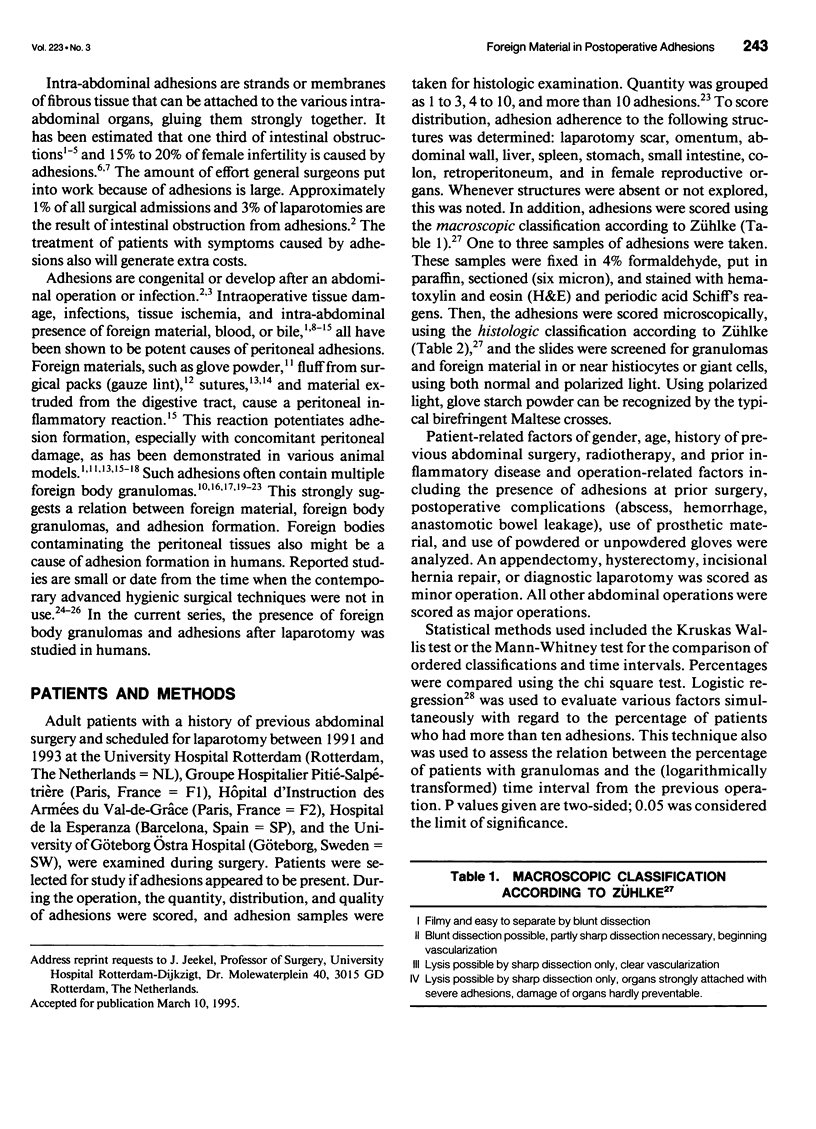
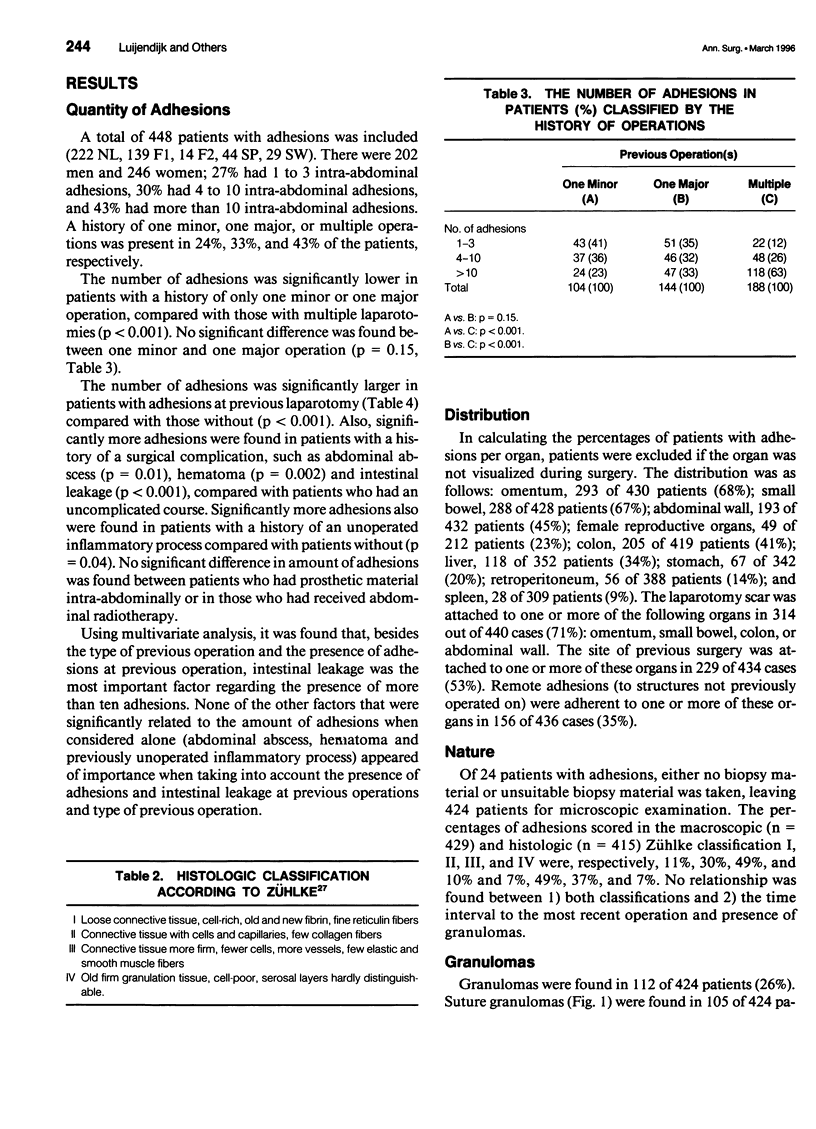
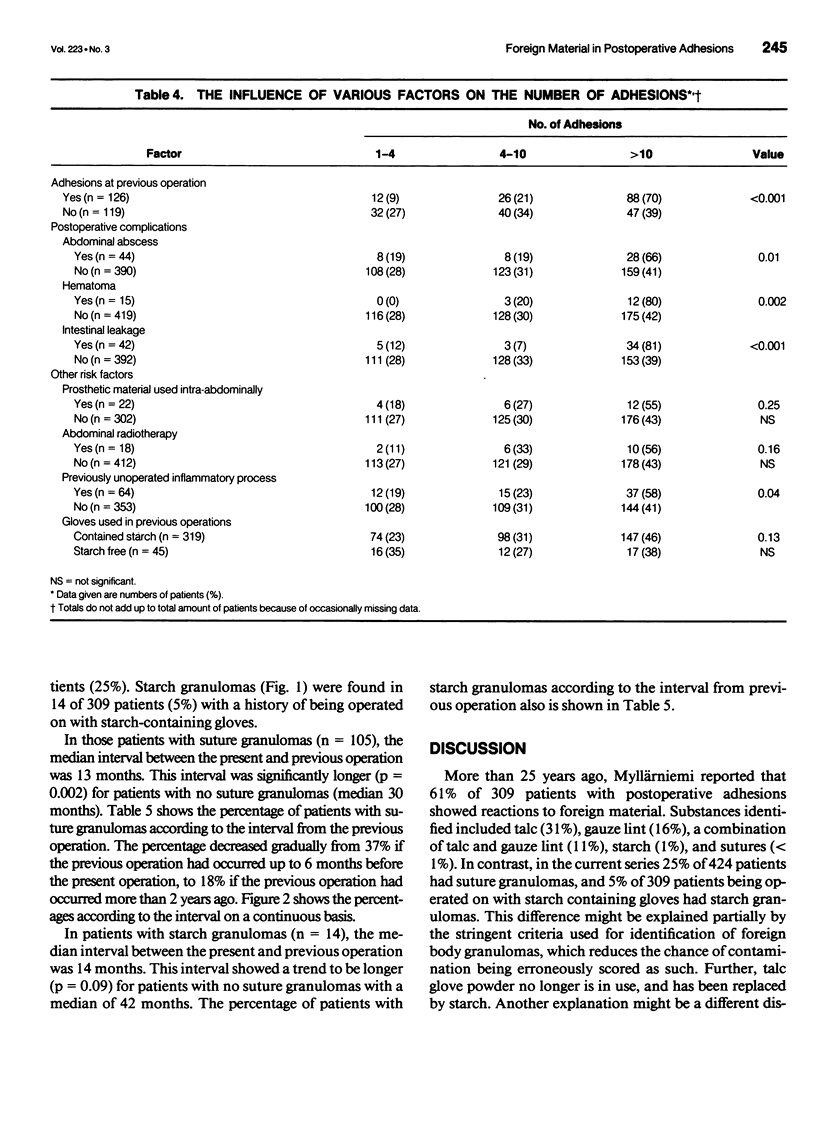
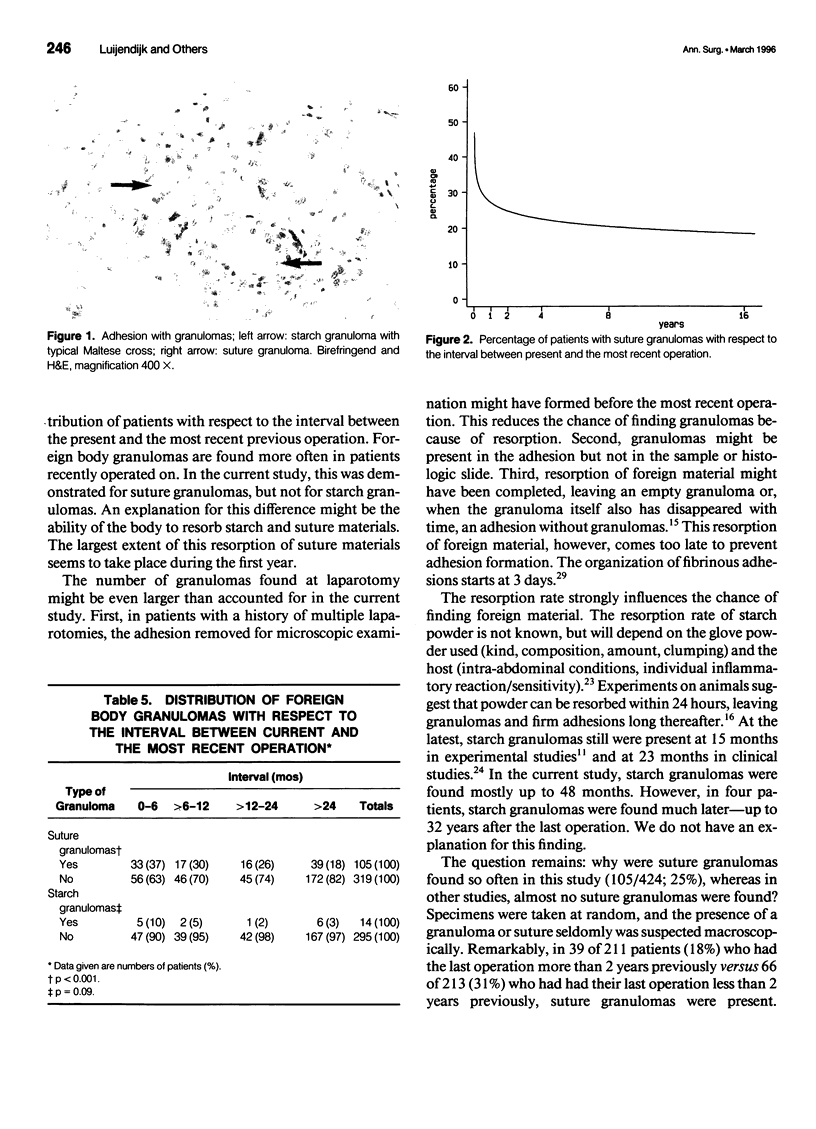
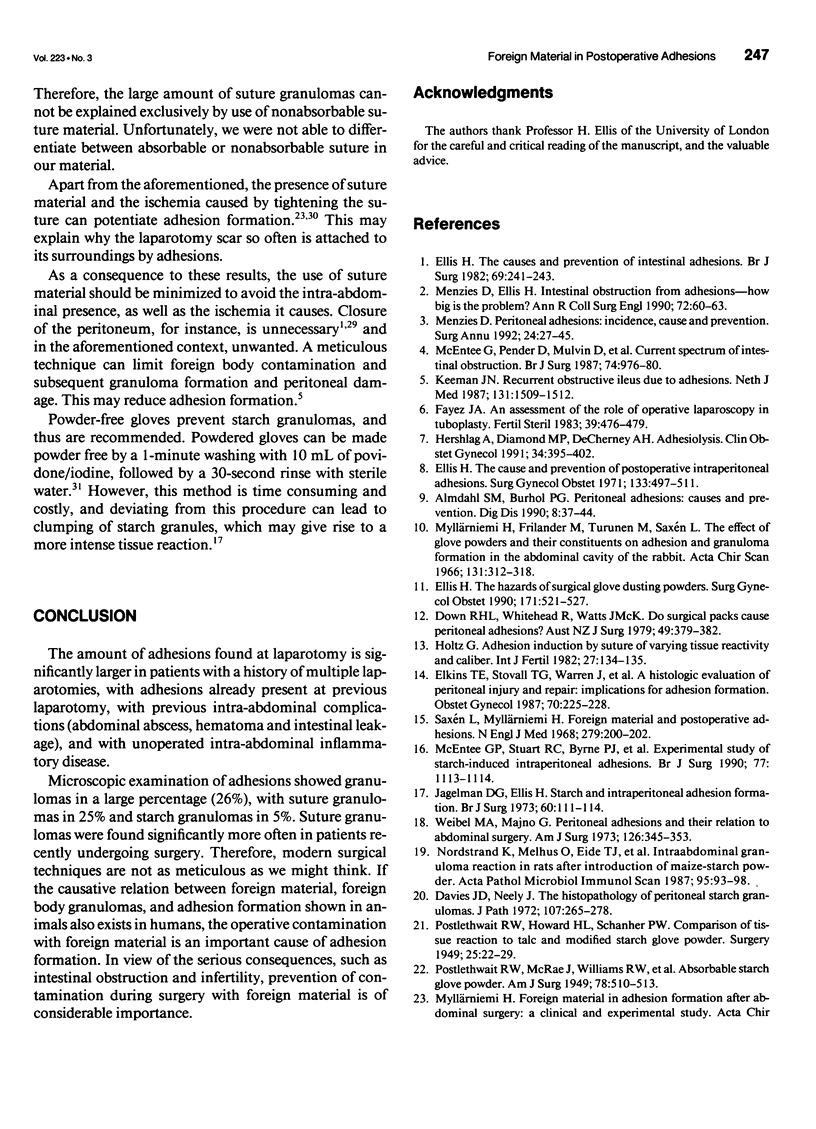

Images in this article
Selected References
These references are in PubMed. This may not be the complete list of references from this article.
- Almdahl S. M., Burhol P. G. Peritoneal adhesions: causes and prevention. Dig Dis. 1990;8(1):37–44. doi: 10.1159/000171238. [DOI] [PubMed] [Google Scholar]
- Cooke S. A., Hamilton D. G. The significance of starch powder contamination in the aetiology of peritoneal adhesions. Br J Surg. 1977 Jun;64(6):410–412. doi: 10.1002/bjs.1800640610. [DOI] [PubMed] [Google Scholar]
- Cox K. R. Starch granuloma (pseudo-malignant seedlings). Br J Surg. 1970 Sep;57(9):650–653. doi: 10.1002/bjs.1800570904. [DOI] [PubMed] [Google Scholar]
- Davies J. D., Neely J. The histopathology of peritoneal starch granulomas. J Pathol. 1972 Aug;107(4):265–278. doi: 10.1002/path.1711070406. [DOI] [PubMed] [Google Scholar]
- Down R. H., Whitehead R., Watts J. M. Do surgical packs cause peritoneal adhesions? Aust N Z J Surg. 1979 Jun;49(3):379–382. doi: 10.1111/j.1445-2197.1979.tb07688.x. [DOI] [PubMed] [Google Scholar]
- ELLIS H. The aetiology of post-operative abdominal adhesions. An experimental study. Br J Surg. 1962 Jul;50:10–16. doi: 10.1002/bjs.18005021904. [DOI] [PubMed] [Google Scholar]
- Elkins T. E., Stovall T. G., Warren J., Ling F. W., Meyer N. L. A histologic evaluation of peritoneal injury and repair: implications for adhesion formation. Obstet Gynecol. 1987 Aug;70(2):225–228. [PubMed] [Google Scholar]
- Ellis H. The cause and prevention of postoperative intraperitoneal adhesions. Surg Gynecol Obstet. 1971 Sep;133(3):497–511. [PubMed] [Google Scholar]
- Ellis H. The causes and prevention of intestinal adhesions. Br J Surg. 1982 May;69(5):241–243. doi: 10.1002/bjs.1800690502. [DOI] [PubMed] [Google Scholar]
- Ellis H. The hazards of surgical glove dusting powders. Surg Gynecol Obstet. 1990 Dec;171(6):521–527. [PubMed] [Google Scholar]
- Fayez J. A. An assessment of the role of operative laparoscopy in tuboplasty. Fertil Steril. 1983 Apr;39(4):476–479. doi: 10.1016/s0015-0282(16)46935-9. [DOI] [PubMed] [Google Scholar]
- Fraser I. Simple and effective method of removing starch powder from surgical gloves. Br Med J (Clin Res Ed) 1982 Jun 19;284(6332):1835–1835. doi: 10.1136/bmj.284.6332.1835. [DOI] [PMC free article] [PubMed] [Google Scholar]
- Hershlag A., Diamond M. P., DeCherney A. H. Adhesiolysis. Clin Obstet Gynecol. 1991 Jun;34(2):395–402. doi: 10.1097/00003081-199106000-00023. [DOI] [PubMed] [Google Scholar]
- Holtz G. Adhesion induction by suture of varying tissue reactivity and caliber. Int J Fertil. 1982;27(3):134–135. [PubMed] [Google Scholar]
- Jagelman D. G., Ellis H. Starch and intraperitoneal adhesion formation. Br J Surg. 1973 Feb;60(2):111–114. doi: 10.1002/bjs.1800600204. [DOI] [PubMed] [Google Scholar]
- Keeman J. N. Recidiverende obstructie-ileus door adhesies. Ned Tijdschr Geneeskd. 1987 Aug 29;131(35):1509–1512. [PubMed] [Google Scholar]
- MCNAUGHT G. H. STARCH GRANULOMA: A PRESENT-DAY SURGICAL HAZARD. Br J Surg. 1964 Nov;51:845–849. doi: 10.1002/bjs.1800511112. [DOI] [PubMed] [Google Scholar]
- McEntee G. P., Stuart R. C., Byrne P. J., Leen E., Hennessy T. P. Experimental study of starch-induced intraperitoneal adhesions. Br J Surg. 1990 Oct;77(10):1113–1114. doi: 10.1002/bjs.1800771012. [DOI] [PubMed] [Google Scholar]
- McEntee G., Pender D., Mulvin D., McCullough M., Naeeder S., Farah S., Badurdeen M. S., Ferraro V., Cham C., Gillham N. Current spectrum of intestinal obstruction. Br J Surg. 1987 Nov;74(11):976–980. doi: 10.1002/bjs.1800741105. [DOI] [PubMed] [Google Scholar]
- Menzies D., Ellis H. Intestinal obstruction from adhesions--how big is the problem? Ann R Coll Surg Engl. 1990 Jan;72(1):60–63. [PMC free article] [PubMed] [Google Scholar]
- Menzies D. Peritoneal adhesions. Incidence, cause, and prevention. Surg Annu. 1992;24(Pt 1):27–45. [PubMed] [Google Scholar]
- Myllärniemi H., Frilander M., Turunen M., Saxén L. The effect of glove powders and their constituents on adhesion and granuloma formation in the abdominal cavity of the rabbit. Acta Chir Scand. 1966 Apr;131(4):312–318. [PubMed] [Google Scholar]
- Nordstrand K., Melhus O., Eide T. J., Larsen T., Giercksky K. E. Intraabdominal granuloma reaction in rats after introduction of maize-starch powder. Acta Pathol Microbiol Immunol Scand A. 1987 Mar;95(2):93–98. doi: 10.1111/j.1699-0463.1987.tb00012_95a.x. [DOI] [PubMed] [Google Scholar]
- POSTLETHWAIT R. W., HOWARD H. L., SCHANHER P. W. Comparison of tissue reaction to talc and modified starch glove powder. Surgery. 1949 Jan;25(1):22–29. [PubMed] [Google Scholar]
- POSTLETHWAIT R. W., McRAE J. T. Absorbable starch glove powder. Am J Surg. 1949 Oct;78(4):510–513. doi: 10.1016/0002-9610(49)90214-7. [DOI] [PubMed] [Google Scholar]
- Raftery A. T. Regeneration of parietal and visceral peritoneum. A light microscopical study. Br J Surg. 1973 Apr;60(4):293–299. doi: 10.1002/bjs.1800600412. [DOI] [PubMed] [Google Scholar]
- Saxén L., Myllärniemi H. Foreign material and postoperative adhesions. N Engl J Med. 1968 Jul 25;279(4):200–202. doi: 10.1056/NEJM196807252790407. [DOI] [PubMed] [Google Scholar]
- Weibel M. A., Majno G. Peritoneal adhesions and their relation to abdominal surgery. A postmortem study. Am J Surg. 1973 Sep;126(3):345–353. doi: 10.1016/s0002-9610(73)80123-0. [DOI] [PubMed] [Google Scholar]



